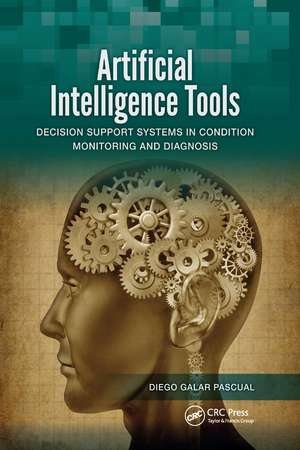Artificial Intelligence Tools: Decision Support Systems in Condition Monitoring and DIagnosis
Autor Diego Galar Pascualen Limba Engleză Paperback – 18 dec 2020
- Addresses nearest-neighbor-based, clustering-based, statistical, and information theory-based techniques
- Considers the merits of each technique as well as the issues associated with real-life application
- Covers classification methods, from neural networks to Bayesian and support vector machines
- Proposes fuzzy logic to explain the uncertainties associated with diagnostic processes
- Provides data sets, sample signals, and MATLAB® code for algorithm testing
Artificial Intelligence Tools: Decision Support Systems in Condition Monitoring and Diagnosis delivers a thorough evaluation of the latest AI tools for CM, describing the most common fault diagnosis techniques used and the data acquired when these techniques are applied.
Preț: 312.43 lei
Preț vechi: 356.63 lei
-12% Nou
Puncte Express: 469
Preț estimativ în valută:
59.78€ • 62.58$ • 49.76£
59.78€ • 62.58$ • 49.76£
Carte tipărită la comandă
Livrare economică 31 martie-14 aprilie
Preluare comenzi: 021 569.72.76
Specificații
ISBN-13: 9780367738358
ISBN-10: 036773835X
Pagini: 549
Dimensiuni: 156 x 234 mm
Greutate: 0.45 kg
Ediția:1
Editura: CRC Press
Colecția CRC Press
ISBN-10: 036773835X
Pagini: 549
Dimensiuni: 156 x 234 mm
Greutate: 0.45 kg
Ediția:1
Editura: CRC Press
Colecția CRC Press
Cuprins
Massive Field Data Collection: Issues and Challenges. Condition Monitoring: Available Techniques. Challenges of Condition Monitoring Using AI Techniques. Input and Output Data. Two-Stage Response Surface Approaches to Modeling Drug Interaction. Nearest-Neighbor-Based Techniques. Clustering-Based Techniques. Statistical Techniques. Information Theory-Based Techniques. Uncertainty Management.
Notă biografică
Diego Galar Pascual holds an M.Sc and Ph.D from Saragossa University, Zaragoza, Spain. He has been a professor at several universities, including Saragossa University and the European University of Madrid, Spain. At Saragossa University, he also served as director of academic innovation, director of international relations, pro-vice-chancellor, and senior researcher in the Aragon Institute of Engineering Research (i3A). In addition, he has been the technological director and CBM manager of international firms such as Volvo, Saab, Boliden, Scania, Tetrapak, Heinz, and Atlas Copco. Currently, he is the professor of condition monitoring in the Division of Operation and Maintenance of the Luleå University of Technology (LTU), Sweden, where he also is involved with the LTU-SKF University Technology Center. Widely published, Dr. Galar Pascual serves as a visiting professor at the University of Valencia (Spain), Polytechnic of Braganza (Portugal), Valley University (Mexico), Sunderland University (UK), University of Maryland (College Park, USA), and Northern Illinois University (DeKalb, USA).
Recenzii
"… a long overdue publication; the condition monitoring community, from newcomers to experts, will find themselves constantly referring to this book, especially to find definitive answers to often debated issues."
—Chris Pomfret, Society for Machinery Failure Prevention Technology, Dayton, Ohio, USA
"… a good reference book for students, educators, and maintenance engineers who would like to use artificial intelligence (AI) techniques for data fusion and decision making in condition monitoring and diagnosis."
—Zhongxiao Peng, University of New South Wales, Sydney, Australia
"… a detailed and descriptive analysis of the latest thinking on data collection and analyses for maintenance task development. … an important addition to the library of existing knowledge to support asset managers, academics, and engineering students who want to understand the methods and techniques to diagnose the state of an asset and develop a new approach to asset management."
—David Baglee, University of Sunderland, UK
"… very comprehensive and informative in its coverage of condition monitoring and condition-based maintenance for machinery. I’m not aware of any other book on the market that has the breadth of coverage of this book. It will be an excellent resource for practitioners in the field. The book contains well-written and very understandable definitions and descriptions of the techniques used for condition monitoring for machinery, providing a useful resource for students and practicing engineers."
—Peter Sandborn, University of Maryland, College Park, USA
—Chris Pomfret, Society for Machinery Failure Prevention Technology, Dayton, Ohio, USA
"… a good reference book for students, educators, and maintenance engineers who would like to use artificial intelligence (AI) techniques for data fusion and decision making in condition monitoring and diagnosis."
—Zhongxiao Peng, University of New South Wales, Sydney, Australia
"… a detailed and descriptive analysis of the latest thinking on data collection and analyses for maintenance task development. … an important addition to the library of existing knowledge to support asset managers, academics, and engineering students who want to understand the methods and techniques to diagnose the state of an asset and develop a new approach to asset management."
—David Baglee, University of Sunderland, UK
"… very comprehensive and informative in its coverage of condition monitoring and condition-based maintenance for machinery. I’m not aware of any other book on the market that has the breadth of coverage of this book. It will be an excellent resource for practitioners in the field. The book contains well-written and very understandable definitions and descriptions of the techniques used for condition monitoring for machinery, providing a useful resource for students and practicing engineers."
—Peter Sandborn, University of Maryland, College Park, USA
Descriere
This book discusses white- and black-box approaches to fault diagnosis in condition monitoring, delivering a thorough evaluation of the latest artificial intelligence tools. It addresses nearest-neighbor-based, clustering-based, statistical, and information theory-based techniques, considering the merits of each technique as well as the issues a
